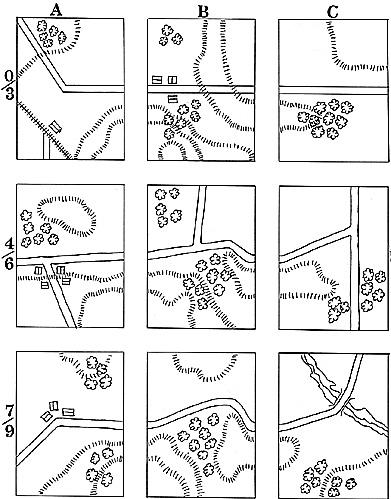The following fictional scenario is based on several nagging doubts that have come to light recently. Nearly all wargames, fictional, historical, book scenario, club meeting, or Saturday night's game with the guys, have one thing in common: They all start with fresh units and armies, just bounding into each other in prime condition.
Jim Birdseye's Scenario Booklet which begins with a chance for mandatory unit losses before the game begins is certainly a step in the right direction, and what is more, got me thinking about my own games. Why not a scenario in which we join the conflict after a first day of fighting? That is, a game based on "the second day"? There are a number of questions we must answer first:
How do we set up terrain for the battle? What were the losses from the first day's fighting? Who won or was winning on the first day? Are either or both sides expecting reinforcements?
On terrain selection, I have been won over to Charles S. Grant's simple but enjoyable system of multiple terrain maps. This ingenious device allows scenarios to be fought and refought several times without boredom.
Thus I present the following 9 maps from which the gamers choose by 3 simple die rolls (D-10) a single map from each of the 3 columns labeled A, B, and C. The three selections are laid side-to-side to describe the battle maps, thus making 27 different terrain possibilities.
Now to the Contending Armies
We will start with 2 basic armies from On To Richmond (OTR). The Union will have 9 infantry brigades of 6 stands each, 4 artillery battalions (3 rifled and 1 smoothbore), and a cavalry brigade of 6 stands. The infantry are 3 divisions of equal size. The artillery may be parcelled out to the infantry divisions or massed in a single artillery reserve which in OTR would require its own movement card. The cavalry as is usual in our Civil War games is an independent brigade. As an extra bit of fun try the following: ascertain how the troopers are armed by rolling a single D10. 0-5 muzzleloaders, 6-8 breechloaders, and 9 repeaters.
The Confederates should be organized similarly, mustering 7 infantry brigades, 6 of which have 8 stands and one which has 6. These are divided into 2 divisions. Reb artillery in 3 batteries (11 of which is rifled), should also be divided between the infantry divisions. Finally, there should be an 8 stand independent cavalry brigade.
Now that we have the armies we must discover how they fared in the previousclay's fighting. The following chart shows how rnany stands each unit lost thus revealing its present strength forthecoming renewal of the struggle. A 6 stand brigade rolling a 5 would have therefore lost 2 stands and begin our scenario at a strength of 4 stands.
INFANTRY & CAVALRY
- ROLL : STANDS LOST
0-1 : 4
2-3 : 3
4-6 : 2
7 : 1
8-9 : 0
| ARTILLERY | ||
|---|---|---|
| ROLL | RESULT | |
| US | CS | |
| 0 | DESTROYED | DESTROYED |
| 1 | 1 HIT | DESTROYED |
| 2-5 | 1 HIT | 1 HIT |
| 6 | OKAY | 1 HIT |
| 7-9 | OKAY | OKAY |
Needless to say, the prudent table warrior will try to rebuild his strength as soon as possible. Once each side has been checked for losses, the side which suffered the greater loss is declared the loser of the first day's conflict. He may then set up his forces one third of the way up from his baseline. The winning side may observe the dispositions of the loser and then set up one half the distance from his baseline or in the middle of the board.
We also assume that the armies have not been slothful in the evening hours. Each side may have up to six 6" earthwork sections for placement if they roll 4 or more on a DIO with the following alterations:
-
+1 for veteran unit rolling
+2 for elite unit rolling
+1 for Cautious or Exceptional divisional CO or CinC
-1 for Firebrand divisional CO or CinC
| REINFORCEMENT CHART | ||
|---|---|---|
| ROLL | RESULT | |
| US | CS | |
| 0 | Nothing | Nothing |
| 1 | 1 Brigade | Nothing |
| 2 | 2 Brigades | 1 Brigade |
| 3 | 2 Brigades, 1 Rif | 2 Brigades |
| 4 | 3 Brigades | 3 Brigades, 1 SB |
| 5 | 3 Brigades, 1 SB | 3 Brigades, 1 Cav Brigade |
| 6 | 1 SB, 1 Rif | 4 Brigades |
| 7 | 6 Brigades, 1 Rif | 4 Brigades, 1 Cav Brigade |
| 8 | 6 Brigades, 1 Rif, 1 SB | 4 Brigades, 1 Rif, 1 SB |
| 9 | 6 Brigades, 2 Rif, 1 SB | 4 Brigades, 1 Rif, 1 SB, 1 Cav Bgde. |
The reinforcements should be organized in 3 brigade divisions for the Yankees and up to 4 brigade divisions for the Rebs. A second roll of the DIO then determines their arrival time, i.e., roll 3, the division arrives on turn 3, etc. A 0 roll means a night reinforcement like at Shiloh and on the board for morning. Now after all these preliminaries the battle may at last commence.

Back to Table of Contents -- Courier Vol. VII #2
To Courier List of Issues
To MagWeb Master Magazine List
© Copyright 1986 by The Courier Publishing Company.
This article appears in MagWeb (Magazine Web) on the Internet World Wide Web.
Other military history articles and gaming articles are available at http://www.magweb.com